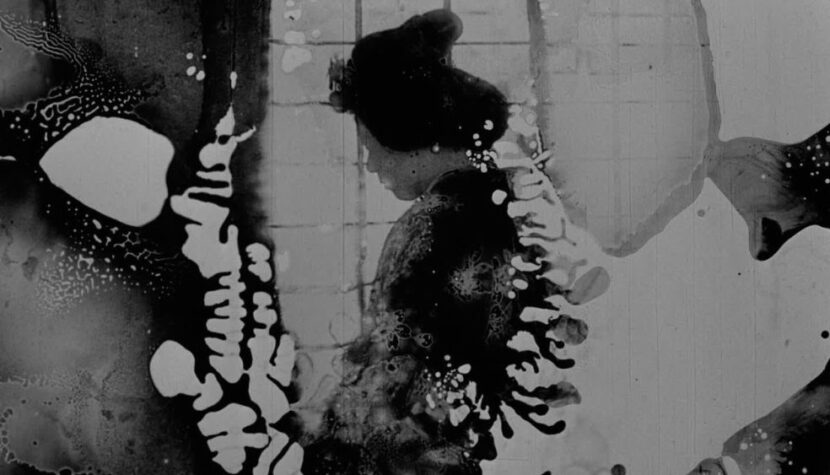DECASIA. Study of Decay, or a Film Without Script, Plot, or Dialogue

Destruction as a special form of creation.
Decasia lacks a script, plot, or dialogue—it’s an experimental collage composed of fragments from nature documentaries, film chronicles, and early cinema works [including The Mind Cure (1912) by Phillips Smalley, The Last Egyptian (1914) by J. Farrell MacDonald, The Man Who Could Not Sleep (1915) by John H. Collins, and Truthful Tulliver (1917) by William S. Hart]. Accompanied by symphonic music, various sequences unfold on the screen: a spinning dervish in slow motion, a boxer delivering a series of punches, a group of children and nuns in a courtyard, carnival festivities, students traveling by bus, a courtroom trial, a kissing couple… But from the very beginning, something is amiss: the boxer strikes into a space resembling a pulsating hole, the rollercoaster carts at the amusement park seem to emerge from nothingness, and the faces of the judge and the accused stretch like rubber.
Most of the film’s fragments were discovered by Bill Morrison in the archives of the Library of Congress and the Moving Image Research Collections at the University of South Carolina. The celluloid reels were so old and neglected that they further degraded during projection. Morrison selected the most “picturesque” examples of negative decay, where the flammable, deformable celluloid deteriorated to the extent that the images began to merge and create abstract patterns on the film. Thus, shreds of films twist and disintegrate before the viewers’ eyes, grotesquely distorting and fading the scenes contained within, before being ground to dust and vanishing forever. And though Decasia lacks traditional elements of a film, such as plot or action, the slightly over-an-hour-long film screening leaves a lasting, thunderous impression on the viewers.

This happens because the entire process of film material decay tells a story nonetheless. Decasia operates on many levels: it’s a fragment of early cinematic art history, a study of the nature of material decay and the impermanence not only of art but also of life itself, and a unique audiovisual spectacle (the music composed by Michael Gordon and performed by an orchestra on intentionally detuned and broken instruments recalls Philip Glass’s soundtracks for Godfrey Reggio’s trilogy). It’s a truly visionary image, resonating with the force of poetic shock and opening entirely new perspectives. Indeed, Decasia is like a glimpse into the history of an unknown civilization, remnants of a lost tribe, or a mysterious artifact of an alien yet somehow familiar form of life.
The spectral human silhouettes in Decasia appear as ghosts. It’s not just that the entropy of celluloid bends their figures into inhuman, surreal shapes. The point is that most likely, all the people we see on screen have long since passed away, turning Morrison’s work into not so much a cinematic experience but a spiritualistic one. One of the most memorable and symbolic sequences is the aforementioned boxer fighting an elusive opponent (perhaps a sparring partner or a punching bag). It almost looks as if this boxer is dueling with the very process of decay, as if trying to overcome inevitable destruction. But disintegration cannot be overcome, so nothingness ultimately triumphs, pouring out like a viscous black abyss across the frame and engulfing the boxer, his opponent, and the room, consuming everything.

Coincidentally, in the same year Decasia premiered, New York composer William Basinski released The Disintegration Loops. It comprised forgotten magnetic tapes from Basinski’s archive, which, during the transfer to digital media, decayed due to age, modifying the sound. In the accompanying booklet to the album, Basinski wrote: “The music was dying in front of my eyes. […] In these musical landscapes were my youth, my lost paradise. […] All of it was slipping away gently, gracefully, beautifully.” What was intended as a sonic representation of nature’s beauty turned into a contemplation of its ruthless impermanence. Furthermore, this occurred on September 11, 2001. Basinski watched the attack on the World Trade Center from his home, listening to dying music that unintentionally became a requiem for the victims.
Decasia is the filmic counterpart to The Disintegration Loops—a striking record of passing and a confirmation that destruction is indeed a special form of creation. As these celluloid tapes fade into nothingness, they simultaneously come to life in a different form. Morrison wasn’t the first filmmaker to undertake such an approach; Peter Delpeut did something similar in Lyrisch Nitrate (1991), but it’s not about precedence here; it’s about triggering a reflection on the essence of everything. Ultimately, what happened to the films creating Decasia is happening to every aspect of the world around us. It’s a film that demands absolute focus, silence, and dimmed lights but offers much in return to those seeking more from life than just popcorn during Dune. Decasia is a hypnotic trance, a strange dream. It’s a one-of-a-kind experience.

